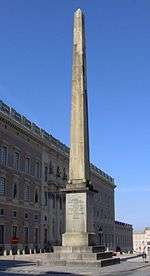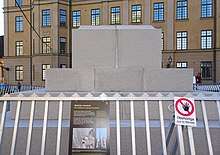Obelisk at Slottsbacken
The Obelisk at Slottsbacken is an obelisk monument adjacent to the Royal Palace on Slottsbacken in Old Town, Stockholm, Sweden. Unveiled in 1800, it commemorates the deeds of Stockholm's citizenry during the Russo-Swedish War. The obelisk is considered to be the very centre point of the Swedish capital city. In 2017 the original obelisk was dismantled due to age- and weather-related damage; it is expected to be replaced by a new stone obelisk in the spring of 2020.

Physical description
The stone obelisk is nearly 30 metres (98 ft) high, including the pedestal of 5 metres (16 ft). It weighs 150 tons and is made up of 17 different pieces of granite, believed to have been quarried in nearby Ulfsunda.[1]
From the Obelisk all street numbers in Stockholm have their common origin - there are only a handful of exceptions, only some small streets originating from the street Birger Jarlsgatan.[2]
History
The obelisk was commissioned by King Gustav III to show his gratitude to the burghers of Stockholm who guarded the city while the king was leading the Swedish-Finnish Navy in the Russian War in 1788-1790.
The neo-Egyptian design of the obelisk was made by the artist Louis Jean Desprez and it was erected by the inventor and colonel-mecanicus Jonas Lidströmer in 1800. The construction was at the time considered to be complicated, since the obelisk is made of many heavy stone boulders, and not cut from one piece as was typically done in classical antiquity.
Gustav III died before the monument was finished, and in October 1800, King Gustav IV Adolf unveiled the obelisk.[1]
2017–2020 replacement

By 2012, the obelisk was showing signs of significant deterioration and the area around the monument was fenced off to protect the public from possible falling stones. In 2017, the obelisk was dismantled and removed for repair and restoration work.[1] The repairs were initially expected to take about a year,[1] but it was later determined that the stones which make up the monument were so damaged they could not be repaired. It was decided to quarry new Bohus granite stones with similar technical and aesthetic properties from an area near Hunnebostrand. It is expected the new obelisk will be completed in the spring of 2020.[3]
References and notes
- "Obelisken på Slottsbacken". www.sfv.se. Statens fastighetsverk. Archived from the original on 24 March 2019. Retrieved 24 March 2019. (In Swedish)
- Stockholms gatunamn (2nd ed.). Stockholm: Kommittén för Stockholmsforskning. 1992. ISBN 91-7031-042-4.
- "Obelisken på Slottsbacken". www.sfv.se. Statens fastighetsverk. Archived from the original on 4 January 2020. Retrieved 5 January 2020. (In Swedish)
See also
| Wikimedia Commons has media related to Obelisken i Stockholm. |